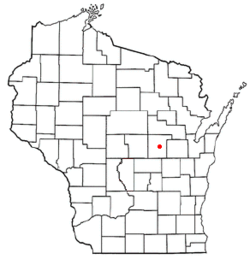Little Wolf, Wisconsin facts for kids
Quick facts for kids
Little Wolf, Wisconsin
|
|
|---|---|

Location of Little Wolf, Wisconsin
|
|
| Country | |
| State | |
| County | Waupaca |
| Area | |
| • Total | 34.0 sq mi (87.9 km2) |
| • Land | 33.5 sq mi (86.8 km2) |
| • Water | 0.4 sq mi (1.1 km2) |
| Elevation | 804 ft (245 m) |
| Population
(2000)
|
|
| • Total | 1,445 |
| • Density | 43.1/sq mi (16.6/km2) |
| Time zone | UTC-6 (Central (CST)) |
| • Summer (DST) | UTC-5 (CDT) |
| FIPS code | 55-45300 |
| GNIS feature ID | 1583587 |
| Website | http://townoflittlewolf.com |
Little Wolf is a small town located in Waupaca County, Wisconsin, in the United States. A "town" in Wisconsin is a type of local government area, similar to a township. In 2000, about 1,445 people lived there.
Contents
History of Little Wolf
Early Settlers and Name Changes
The area that is now Little Wolf was first settled in 1848 by William Goldberg. Other families, like George E. and J.P. More, joined him in 1849. James and Peter Meiklejohn arrived in 1850. These early settlements were built along the river on the southern edge of the area.
The town was first called Centerville. It was officially organized on March 5, 1852. Later, on November 15, 1854, its name was changed to Little Wolf. For a short time, after Jack Brickley built the first bridge across the river in 1858, it was also known as Brickley Bridge. However, the name Little Wolf became permanent when A. P. Jones opened a new post office there in January 1859.
Town Divisions and Growth
Over the years, parts of Little Wolf became separate towns. The Town of Royalton separated in 1853. The Town of Union left Little Wolf in 1857. Then, the Town of Dupont separated from the Town of Union in 1864.
The Little Wolf area grew quite fast in its first ten years. Goldberg and the Mores built a sawmill in 1849. Andrew Van Adestine opened a smithy, which is a place where a blacksmith works with metal. Dan Smith and A. P. Jones opened grocery stores. Jack Brickley built the important bridge over the river.
Community Buildings and Decline
In 1853, Peter Meiklejohn set aside a room in his house for the village's first teacher, Miss Fortner, to use as a classroom. By 1857, the village had built its own schoolhouse. That same year, Meiklejohn opened a grist mill on the southwest bank of the river. A grist mill is a place where grain is ground into flour. A two-story hotel, also run by the Meiklejohns, was located near the grist mill.
However, Little Wolf did not continue to grow much larger. It likely began to decline in the 1870s. This happened after another lumbermill was built further upriver in 1871. Also, the railroad was built through Manawa in 1873, bypassing Little Wolf. For a long time, only the hotel and the foundations of the grist mill remained to show that the village had ever existed. Today, even the hotel is gone.
Geography of Little Wolf
Little Wolf covers a total area of about 34.0 square miles (which is about 87.9 square kilometers). Most of this area, about 33.5 square miles (86.8 square kilometers), is land. The remaining 0.4 square miles (1.1 square kilometers) is water, making up about 1.27% of the total area.
Population and People
Demographics from 2000 Census
According to the census taken in 2000, there were 1,445 people living in Little Wolf. These people lived in 511 households, and 414 of these were families. The population density was about 43.1 people for every square mile (or 16.6 people per square kilometer). There were 544 housing units, meaning places where people live.
Most of the people in Little Wolf were White (about 98.89%). A small number of residents were African American, Native American, or Asian. Some people identified as being from other races or from two or more races. About 0.97% of the population identified as Hispanic or Latino.
Household and Family Life
Out of the 511 households, about 38.0% had children under 18 years old living with them. Most households (73.0%) were married couples living together. About 5.1% had a female head of household with no husband present. The remaining 18.8% were non-families, meaning they were individuals or groups of unrelated people living together.
About 15.5% of all households were made up of just one person. And 7.6% of households had someone living alone who was 65 years old or older. On average, there were 2.83 people in each household and 3.15 people in each family.
Age and Income
The population in Little Wolf was spread out by age. About 28.9% were under 18 years old. About 6.0% were between 18 and 24. The largest group, 30.4%, was between 25 and 44. About 23.2% were between 45 and 64, and 11.5% were 65 years old or older. The median age (the middle age) was 37 years. For every 100 females, there were about 106.7 males.
The median income for a household in the town was $47,692. For a family, the median income was $52,344. Males generally earned more, with a median income of $33,693, compared to $22,399 for females. The per capita income (income per person) for the town was $17,692. About 5.1% of families and 7.5% of the total population lived below the poverty line. This included 10.1% of those under 18 and 5.9% of those 65 or older.
See also
 In Spanish: Little Wolf (Wisconsin) para niños
In Spanish: Little Wolf (Wisconsin) para niños

